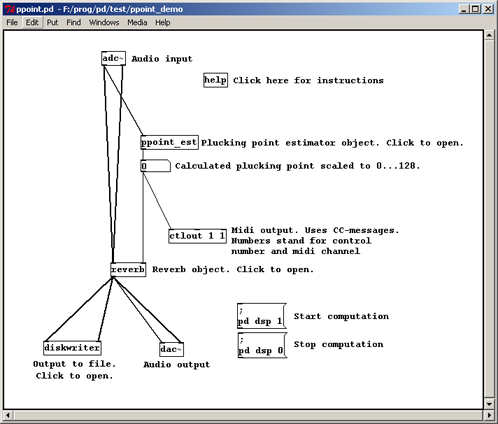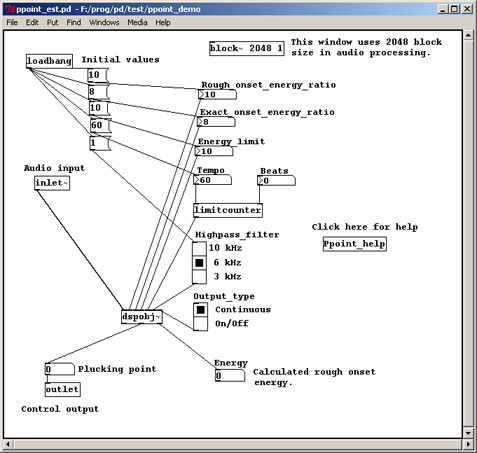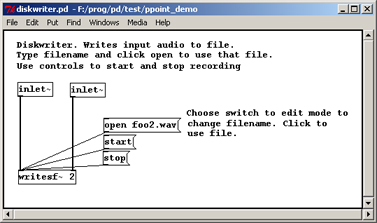The program estimates the plucking point on the string of an acoustic guitar.
The calculated value is used to control the reverberation time of a reverb effect.
The main window of the program is presented in Figure 1.
 Figure 1. The main window of PULMU the plucking point estimator.
Ppoint_est
Figure 1. The main window of PULMU the plucking point estimator.
Ppoint_est object is the plucking point estimator unit. It has one audio input for signal to
be analysed and one control output for calculated plucking point value.
In the box below the
ppoint_est -object is a number box that shows the calculated result.
From this box the control signal goes to the reverb object and to MIDI output.
The output of the reverb object is directed to the diskwriter-object and to the audio output, which are in parallel.
Audio input and output objects use Pd's own audio interface as well as MIDI output.
Plucking Point Estimator ppoint_est
The plucking point estimator window presented in Figure 2 can be opened by clicking the
ppoint_est object in the main window.
 Figure 2. The plucking point estimator.
Figure 2. The plucking point estimator.
The
dspobj~-object is the actual plucking point estimator external written in C.
It has one audio input and several control inputs and outputs.
The estimator has several user controlled parameters:
- Rough_onset_energy_ratio (Sensitivity)
This defines how much signal energy must raise in a short period of time in order to a pluck to be detected.
Possible values are between 1 and 20. Default is 10. Low values (<5) cause false pluck detections due to scratching noises
made with the left or the right hand. Higher values (>15) make detection more difficult and may cause some plcuks to be missed.
- Exact_onset_energy_ratio
Like Rough_onset_energy_ratio this defines how easily plucks are detected.
Also with this parameters low values cause false detections and high values make detection more difficult, i.e.,
or the whole process less sensitive for plucks.
- Energy_limit
This parameter defines the minumum signal energy an input signal must exceed in order to a pluck to be detected.
Low values cause false detections, because of players hand movements on the guitar neck and other noises.
High values make detection more coarxe. The calculated energy is shown in a box placed in the lower right corner of the plucking
point estimator window.
- Tempo and beats
Tempo and beats define how much time must pass after detected pluck that a new pluck is detected.
For example if beats is four and tempo is 120, a new pluck is not detected until four beats are passed at the tempo of 120.
Zero beats mean that no time is waited after a pluck is detected.
- High pass filter cutoff frequency
Input signal is highpass filtered before energy calculations. Higher cutoff frequency helps to detect rapid plucks, but at the same makes detection of the plucks on the thick strings harder.
- Output_type
User can choose between continous output (1...127) and on/off (1 or 100) output.
Diskwriter
Diskwriter writes the audio output signal of PULMU to the hard disk of your computer.
The diskwriter object can be opened by clicking it in the main window. Figure 3 shows a view of the diskwriter.
 Figure 3. The diskwriter object window.
Figure 3. The diskwriter object window.
The diskwriter has a stereo audio input, a control for changing the output filename and controls for starting and
stopping the recorging.
MIDI
The plucking point estimation result can also control an extrernal audio effect via MIDI. An audio device that can be controlled via MIDI is connected with a MIDI cable to your computer soundcard.
The output of the plucking point estimator is also sent to a MIDI output.
The MIDI output uses MIDI control change (CC) messages. The MIDI output is defined using Pd's internal MIDI
ctlout object.
It has two parametres, the MIDI channel and control number.

